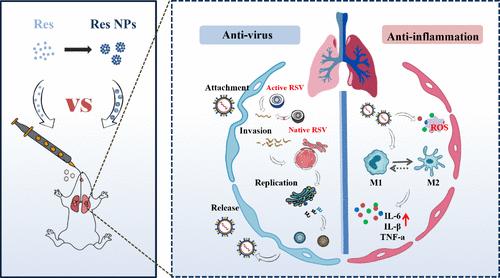Sonication-Assisted Self-Assembled Resveratrol Nanoparticles with Enhanced Antiviral and Anti-inflammatory Activity against Respiratory Syncytial Virus-Induced Pneumonia
IF 8.3
2区 材料科学
Q1 MATERIALS SCIENCE, MULTIDISCIPLINARY
引用次数: 0
Abstract
Respiratory syncytial virus (RSV)-induced viral pneumonia in children is common worldwide. Its high occurrence and lack of an effective vaccine make it a leading cause of death in children. Severe RSV infection can trigger uncontrolled inflammatory responses in patients, so the development of small molecule drugs with the dual function of “direct antivirus” and “inflammatory response regulation” is welcome. Resveratrol (Res) has been reported to have antiviral and anti-inflammatory pharmacological effects, but its application is limited because of its poor water solubility and oral bioavailability. Based on small-molecule nanotechnology, we developed a sonication-assisted self-assembly method for preparing insoluble Res into highly soluble resveratrol nanoparticles (Res NPs). The obtained Res NPs exhibited a higher water solubility and a faster dissolution rate, which was more conducive to the effectiveness of Res in addressing RSV-induced viral pneumonia. In vitro studies had shown that Res NPs played an antiviral role by inhibiting RSV replication and reducing the production of pro-inflammatory cytokines. Nebulized inhalation administration of Res NPs prolonged the drug’s residence time in the lungs, which appears to increase the accumulation and effectiveness of Res NPs. Additionally, in vivo studies had demonstrated significant benefits of Res NPs in inhibiting RSV viral load and improving the pulmonary microenvironment in RSV-infected mice. Both antiviral and anti-inflammatory experiments had confirmed that the pharmacological activity of Res NPs is superior to that of Res. This suggested that nanosizing Res was an effective way to enhance the original pharmacological activity of Res and also offered a new formulation strategy for treating viral pneumonia.

声波辅助自组装白藜芦醇纳米颗粒对呼吸道合胞病毒引发的肺炎具有更强的抗病毒和抗炎活性
呼吸道合胞病毒(RSV)诱发的儿童病毒性肺炎在全世界都很常见。其高发率和缺乏有效疫苗使其成为儿童死亡的主要原因。严重的 RSV 感染会引发患者失控的炎症反应,因此具有 "直接抗病毒 "和 "炎症反应调节 "双重功能的小分子药物的开发备受欢迎。据报道,白藜芦醇(Res)具有抗病毒和抗炎的药理作用,但由于其水溶性和口服生物利用度较差,其应用受到限制。基于小分子纳米技术,我们开发了一种超声辅助自组装方法,将不溶性的白藜芦醇制备成高溶性的白藜芦醇纳米颗粒(Res NPs)。所获得的白藜芦醇纳米粒子具有更高的水溶性和更快的溶解速度,这更有利于白藜芦醇在解决 RSV 引起的病毒性肺炎方面的有效性。体外研究表明,Res NPs 通过抑制 RSV 复制和减少促炎细胞因子的产生发挥了抗病毒作用。雾化吸入 Res NPs 可延长药物在肺部的停留时间,这似乎增加了 Res NPs 的积累和有效性。此外,体内研究表明,Res NPs 在抑制 RSV 病毒载量和改善 RSV 感染小鼠的肺部微环境方面具有显著疗效。抗病毒和抗炎实验都证实了 Res NPs 的药理活性优于 Res,这表明纳米化 Res 是增强 Res 原始药理活性的有效方法,也为治疗病毒性肺炎提供了一种新的制剂策略。
本文章由计算机程序翻译,如有差异,请以英文原文为准。
求助全文
约1分钟内获得全文
求助全文
来源期刊

ACS Applied Materials & Interfaces
工程技术-材料科学:综合
CiteScore
16.00
自引率
6.30%
发文量
4978
审稿时长
1.8 months
期刊介绍:
ACS Applied Materials & Interfaces is a leading interdisciplinary journal that brings together chemists, engineers, physicists, and biologists to explore the development and utilization of newly-discovered materials and interfacial processes for specific applications. Our journal has experienced remarkable growth since its establishment in 2009, both in terms of the number of articles published and the impact of the research showcased. We are proud to foster a truly global community, with the majority of published articles originating from outside the United States, reflecting the rapid growth of applied research worldwide.
 求助内容:
求助内容: 应助结果提醒方式:
应助结果提醒方式:


